Samsung Galaxy A26 vs Galaxy A36: how much to spend on a midranger?
We may earn a commission if you make a purchase from the links on this page.

Samsung Galaxy A26 vs Galaxy A36 Intro
Samsung's midrange Galaxy A series enjoys a pretty good reputation in the midrange market. They are not as costly as the big Galaxy S series, but come with AMOLED screens built with Samsung's expertise, even offering 120 Hz refresh rates. And the A26 starts at $299, showing that this is perfectly possible nowadays, unlike other manufacturers who make $700 phones with 60 Hz panels.
OK then, which corners are cut? Naturally, you can't expect the processor to be as powerful as a top-tier Samsung phone, and the cameras do take a hit as well. The question is — by how much? Plus, Samsung states that the Galaxy A series now also come with AI — is it a full suite of features, or just a limited one?
For anyone who has made the decision to not spend a fortune on a new phone, the even bigger question is — is there a huge difference between the Galaxy A26 and Galaxy A36? These are priced $100 apart, is there a $100 difference of how much phone you get between them? Well, let's dive in.
Samsung Galaxy A26 vs Galaxy A36 differences explained:
| Galaxy A26 | Galaxy A36 |
|---|---|
| Plastic frame Slightly thicker bezel Glass back | Plastic frame Screen bezel is a bit thinner Glass back |
| 6.7-inch Super AMOLED 120 Hz, no AOD | 6.7-inch Super AMOLED 120 Hz, supports AOD |
| Triple camera Third lens is macro, not zoom | Triple camera Third lens is macro, not zoom |
| Samsung Exynos 1380 (5 nm) chip | Qualcomm Snapdragon 6 Gen 3 (4 nm) chip |
| 6 GB / 128 GB | 6 GB / 128 GB |
| 5,000 mAh battery Fast 25 W charging | 5,000 mAh battery Faster 45 W charging |
| No wireless charging | No wireless charging |
Table of Contents:
Also read:
Design and Display Quality
Still carrying the Samsung DNA
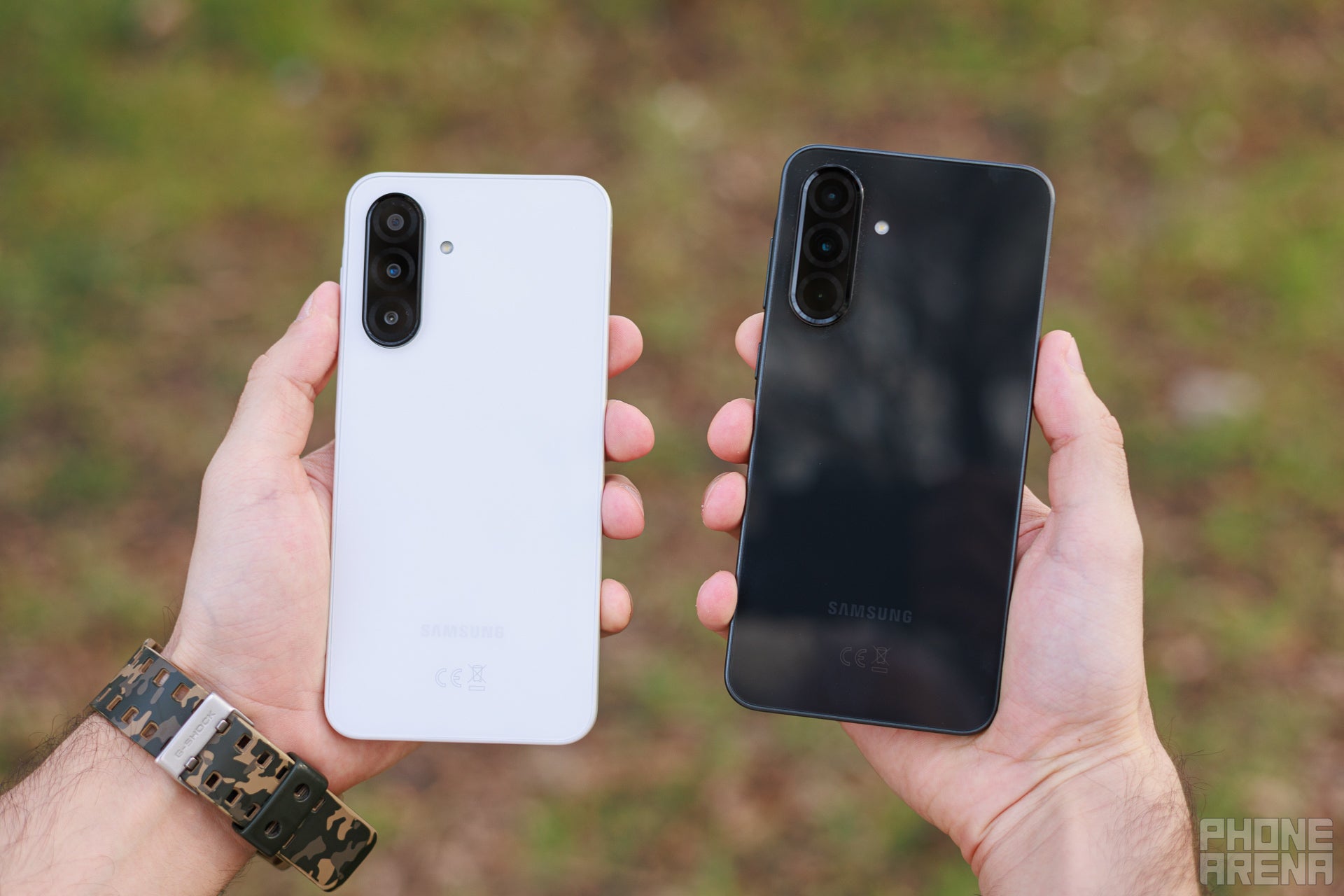
Both of these phones cut a lot of corners to come at a very competitive price. The first thing to go is the metal frame — both have plastic ones, though it's worth mentioning that their glass backs are Gorilla Glass Victus+. One might argue that they didn't need a glass back since they don't have wireless charging, and we kind of agree. Would've been fun for Samsung to save some money on the glass and invest in a different design or different material — like Motorola's excellent faux leather backs.
The Galaxy A26 is slightly bigger and about a millimeter thicker than the Galaxy A36, and you can kind of feel it. Side by side, it's the latter one that feels just a bit more refined. On color options, the A26 comes in a selection of fun solids, while the Galaxy A36 has these gradient, chameleon-like finishes that may look a bit tacky to some.
Both phones are rated IP67, which means they should be dust-tight and survive submersions in small bodies of water for a limited time.
On the front, you will notice that the thicker bezel of the Galaxy A26 also extends to a waterdrop shape for the selfie camera cutout. The Galaxy A36 looks cleaner with a slimmer frame but also a single cutout for the camera, though, a cutout is still there.
Otherwise, the screens have pretty identical specs — 1080p Super AMOLED panels with 120 Hz refresh rates, despite these being budget phones is pretty good.
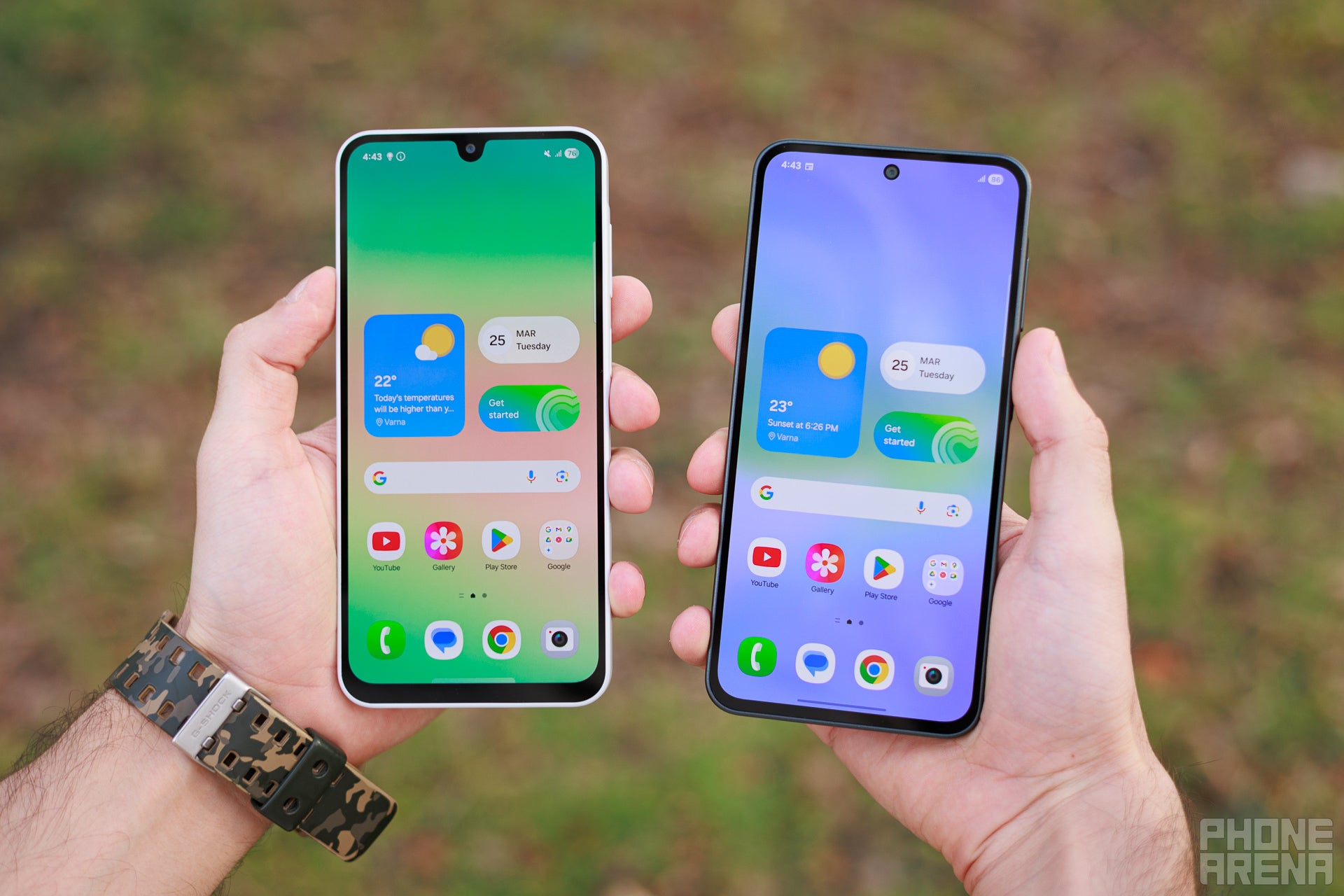
Display Measurements:
However, it's worth noting that the Galaxy A36 can get noticeably brighter, and its panel is slightly more accurate, while the Galaxy A26 veers towards stronger saturation for punchier presentation.
Also, despite the fact that both are Super AMOLED panes with seemingly similar qualities, only the Galaxy A36 supports Always-On Display here. The Galaxy A26 doesn't offer that option. Basically, you'd be missing out on seeing an always-on clock on a dark background, and notification icons when you have something waiting for your attention.
You also get an optical fingerprint scanner under the screen on the Galaxy A36. It's fairly quick and accurate, just not as fancy or super-secure like the ultrasonic tech in Galaxy S series. Still secure enough for banking apps. The Galaxy A26 has fingerprint scanning embedded in the power button. That's fine operationally, not very convenient when the phone is lying on a table or perched on a stand or mount.
Performance and Software
Exynos rising against the Snapdragon. Well, its little cousin, at least
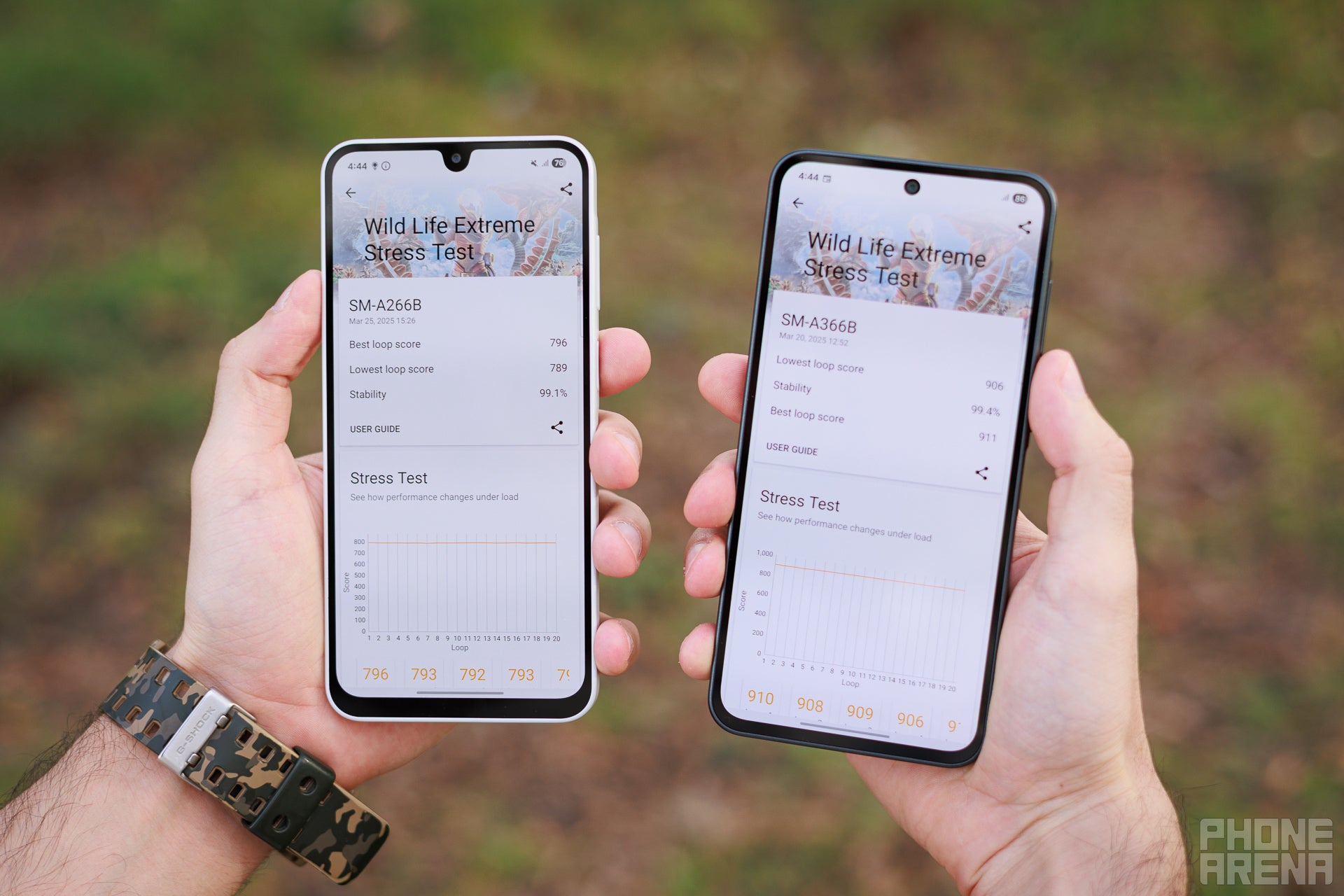
For the Galaxy A26, Samsung went with its in-house Exynos 1380 chip to save on some extra costs. The Galaxy A36 gets the Qualcomm Snapdragon 6 Gen 3. And while Snapdragon is a prestigious name in Android chips land, the 6 series is still on the budget end. Still, the Exynos uses an older 5 nm build process, while the Snapdragon 6 Gen 3 is built on 4 nm, which means it should be more energy-efficient, maybe a bit more powerful. It's worth noting that both can top out at 2.4 GHz of power, but the Exynos has two high-power cores, while the Snapdragon has 4.
Of course, the benchmarks will reveal more:
Interestingly enough, the Exynos 1380 doesn't back down and both processors score about the same. But yes, the 3DMark test shows that the Snapdragon's GPU is slightly more powerful. But when using both phones side by side, we can't say one has superior performance. They are both fine, if a bit slow if you've been spoiled by top-tier flagships. The overall feel of the Galaxy A26 is slightly lower quality, due to the build and bezel differences, but we'd put them in about the same class for performance and software experience.
Performance Benchmarks:
Interestingly enough, the Exynos 1380 doesn't back down and both processors score about the same. But yes, the 3DMark test shows that the Snapdragon's GPU is slightly more powerful. But when using both phones side by side, we can't say one has superior performance. They are both fine, if a bit slow if you've been spoiled by top-tier flagships. The overall feel of the Galaxy A26 is slightly lower quality, due to the build and bezel differences, but we'd put them in about the same class for performance and software experience.
Of course, it's not all about the processor. Both phones come with 6 GB of RAM and 128 GB of UFS 2 storage, both of which will also affect overall performance.
You will get One UI 7 to enjoy the new interface and new icons, plus some limited AI features.Key word - limited. Like the ability to lift an object out of a photo and make it into a sticker or just export it as a picture with transparent background — great feature for making thumbnails. You also get a magic eraser. But you don't get to move around and resize objects in photos like you do on the flagships.
Also, the ability to summarize is gone. The Samsung Internet browser will still have an AI icon at the bottom, but instead of offering you to summarize the website you are viewing, it will have only one option there — read aloud.
At least both phones have Gemini on board and you can lean back to that when/if you need some AI heavy lifting.
Camera
Similar specs, similar results
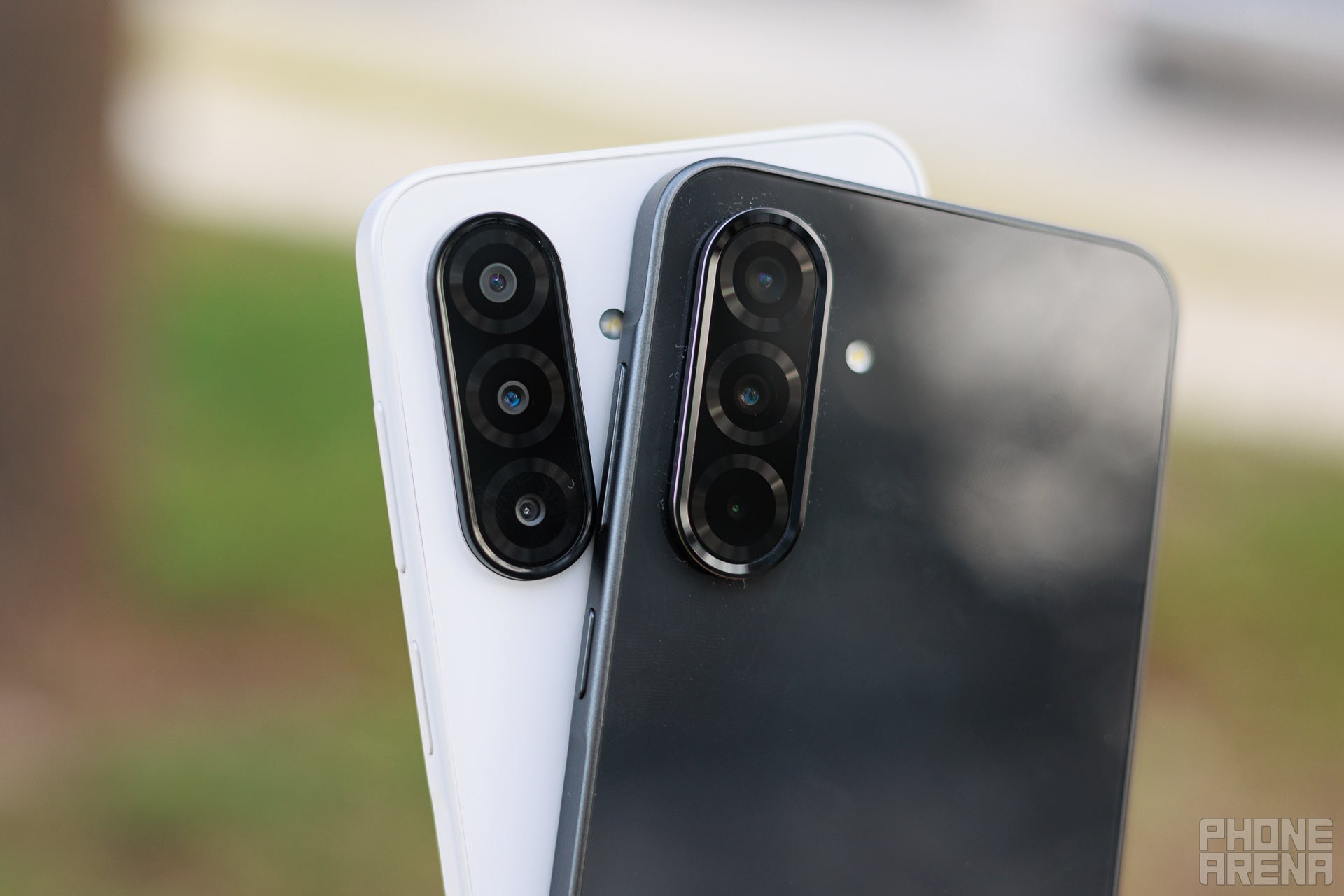
Both of these phones come with 50 MP main cameras, but it's worth noting that they don't carry the same sensors. The resolution is the same, but the sensor in the Galaxy A36 is bigger, which should translate to slightly better low-light performance and less cases of shaky-hand blurriness.
Next they sport 8 MP ultra-wide cameras, which seem to be the same.
Though they have triple cameras, none of them is equipped with a zoom lens. Instead, the third one is a macro camera on each — a 2 MP on the Galaxy A26 and 5 MP on the Galaxy A36.
PhoneArena Camera Score:
Comment briefly on the scores
Main Camera
Both are similar, but we can see how the Galaxy A36 managed to get slightly more vivid colors. It also has a deeper contrast and slightly better details in this image, while the Galaxy A26 can look a bit soft and a little washed out in comparison.
Low-light studio with the curtains down, we can spot some more differences. The A26 is busy amping up the exposure and cleaning noise, which results in it dialing the saturation up — that's a common side effect of these smaller-sensor phone cameras. The Galaxy A36 got out a bit clearer details, but veered in the other extreme where the colors are a bit blander. But at least the second one is closer to reality.
Zoom Quality
None of these phones have a dedicated zoom camera, so they cap out at 10x digital zoom, at which point both look quite washed out and pixel-ey. You could say that the Galaxy A36 is slightly better, as it attempts to achieve some sort of sharpness, but its 10x pictures look curiously jagged in the end.
At 2x zoom, the Galaxy A36 definitely holds it together a bit better, with more realistic detail — no doubt thanks to that bigger sensor.
These seem to have the same ultra-wide cameras, but their color calibration is kind of wonky and unpredictable. Sometimes one has a warmer cast, the other one is cool and slihgtly overexposed, in other scenes they switch places. In general, they are 8 MP ultra-wide cameras — a bit hazy-looking, generally OK for landscape and artsy shot, but expect a bit more noise and soft details.
The Galaxy A26 has a 13 MP selfie camera, the A36 — 12 MP. Obviously, we are dealing with completely different sensors but it also seems like the Galaxy A26 is not keen on using HDR for selfie shots. Something to keep in mind when taking selfies out in the day.
Ultra-wide Camera
These seem to have the same ultra-wide cameras, but their color calibration is kind of wonky and unpredictable. Sometimes one has a warmer cast, the other one is cool and slihgtly overexposed, in other scenes they switch places. In general, they are 8 MP ultra-wide cameras — a bit hazy-looking, generally OK for landscape and artsy shot, but expect a bit more noise and soft details.
Selfies
The Galaxy A26 has a 13 MP selfie camera, the A36 — 12 MP. Obviously, we are dealing with completely different sensors but it also seems like the Galaxy A26 is not keen on using HDR for selfie shots. Something to keep in mind when taking selfies out in the day.
More Camera Samples
Battery Life and Charging

Both of these smartphones sport rather large 5,000 mAh batteries, so we could expect equally good endurance from both. But with different processors, we may get slight deviations. Specifically, the 4 nm pathways of the Snapdragon 6 Gen 3 should be more efficient than the 5 nm Exynos 1380. So, let's see:
PhoneArena Battery and Charging Test Results:
OK, we did expect a bit of a difference, but the Galaxy A36 exceeded expectaitions. Either that or the A26 failed to meet them. When browsing, the Galaxy A36 gives us a full 5 and a half hours more, which is definitely a noteworthy improvement. But also, when gaming, the Galaxy A36 holds it together pretty well and still gives us 9 hours of screen on time, while the Galaxy A26 crumbles to 5 hours. We guess we have the endurance winner of this competition!
The Galaxy A26 charges with 25 W max, the Galaxy A36 can use 45 W chargers. But none of these will give you wireless charging.
Audio Quality and Haptics
These sound mostly OK. They are a bit tinny and harsh in the upper mids, specifically the Galaxy A26 which can get unpleasant. But there is some bass to the speakers, so they are not super-thin. We wouldn't be enjoying music or most media through them, but they can get the message of a notification across and should work quite well for speech with their pronounced upper-midrange.
The haptics aren't fantastic. The motor in the Galaxy A36 is a bit weaker, adding just a slight hint of vibration for a gentle feeback, whereas the Galaxy A26 feels much stronger. Curiously, when we go to edit vibration instensity, the Galaxy A36 lets us do so for Calls, Notifications, System, and Media, whereas the Galaxy A26 only has the System slider.
At the end, both have a vibration that feels raspy and delayed, so the haptic feedback is not super-satisfying and adds a feeling of sluggishness to both of these phones.
Specs Comparison
The Galaxy A26 vs Galaxy A36 specs comparison goes like this:
| Galaxy A26 | Galaxy A36 |
|---|---|
| Size and Weight 6.46 x 3.05 x 0.30 inches (164 x 77.5 x 7.7 mm) 200.0 g | Size and Weight 6.41 x 3.08 x 0.29 inches (162.9 x 78.2 x 7.4 mm) 195 g |
| Display 6.7-inch, 1080p Super AMOLED 120 Hz | Display 6.7-inch, 1080p Super AMOLED 120 Hz |
| Processor Exynos 1380 (5nm) 2.4 GHz | Processor Snapdragon 6 Gen 3 (4 nm) 2.4 GHz |
| Versions 6 / 128GB for $299 | Versions 6 / 128GB for $399 |
| Cameras 50 MP main, f/1.8 8 MP ultra-wide, f/2.2 2 MP macro 13 MP front | Cameras 50 MP main, f/1.8 8 MP ultra-wide, f/2.2 5 MP macro 12 MP front |
| Battery 5,000 mAh | Battery 5,000 mAh |
| Charging 25W wired | Charging 45 W wired |
Which one should you buy?
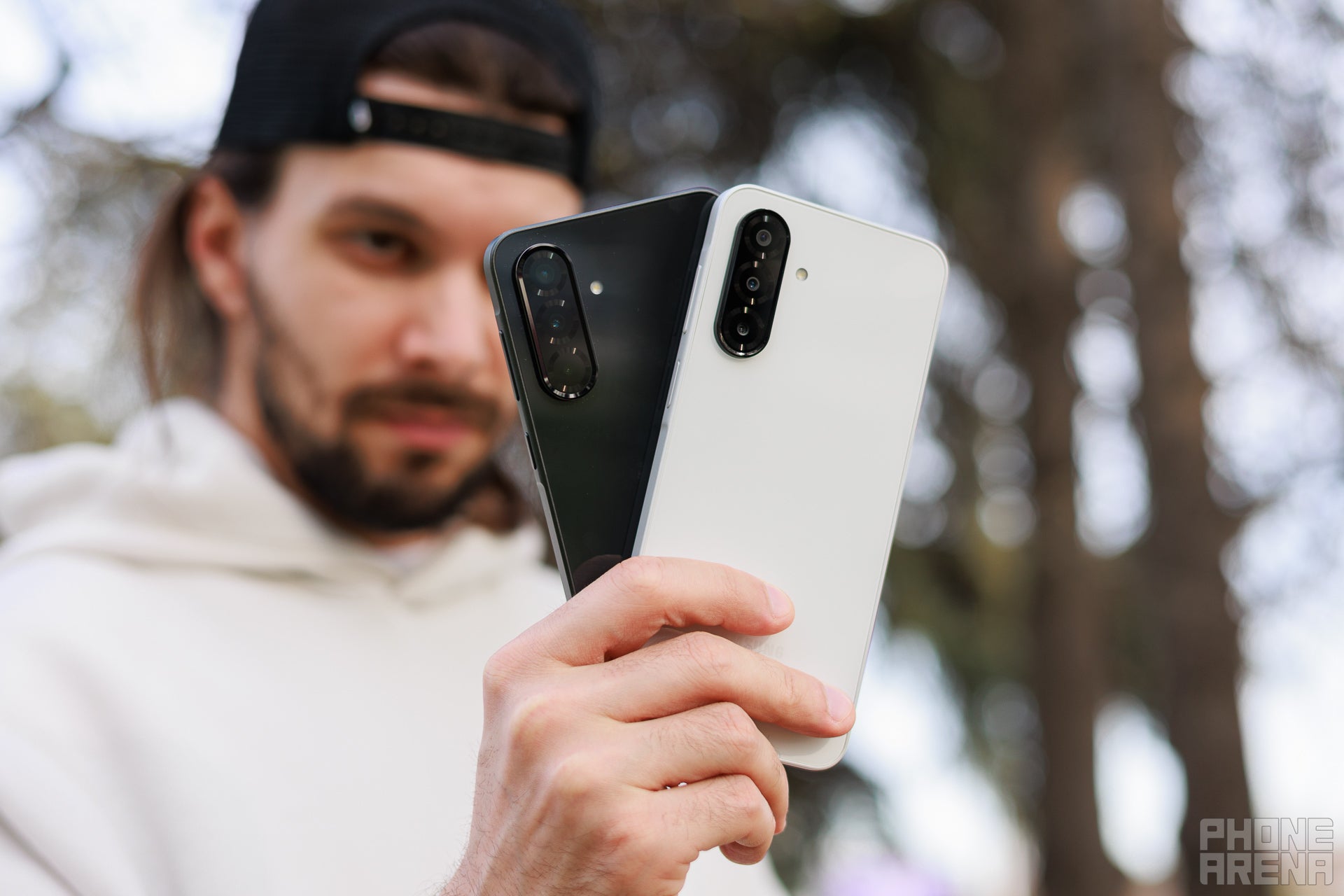
Of course, the simple answer is always "the expensive one should be better". Does the Galaxy A36 warrant asking for $100 on top of what the Galaxy A26 offers? Not entirely, at least not in performance and camera. However, that battery life definitely looks much better on the A36, and its overall design is slightly more pleasing to the eye. Plus, the front-mounted fingerprint scanner is much more convenient in the long run than the side-placed one.
We are still having a hard time outright saying it's $100 better, but maybe that's a testament to the Galaxy A26 and how much value it offers for its $299 asking price. If you are tight on budget, it should do you just fine. If you can spare the extra cash, the Galaxy A36 will have a better user experience in the long run.
Follow us on Google News

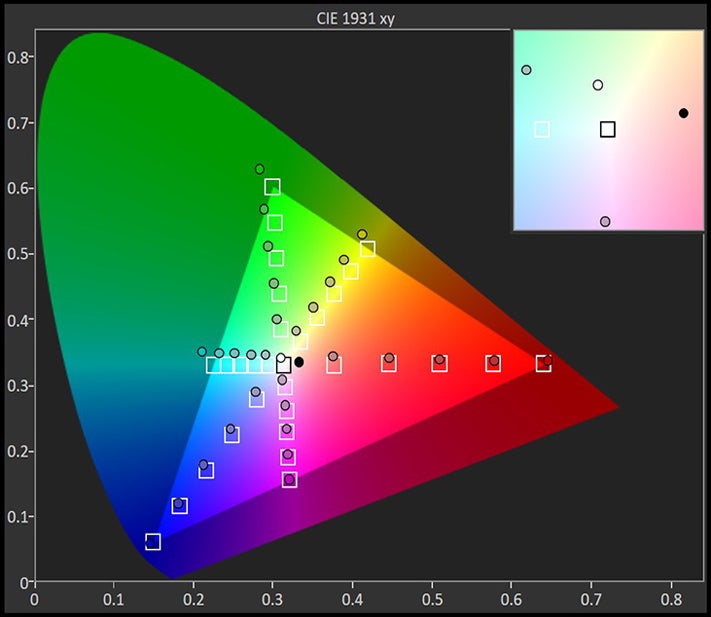



















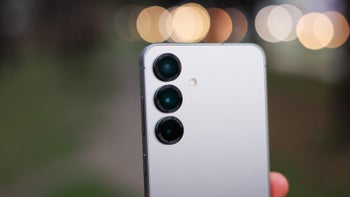
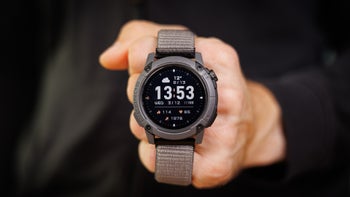
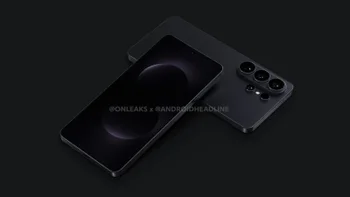
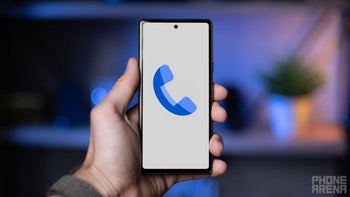

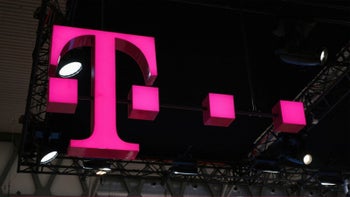

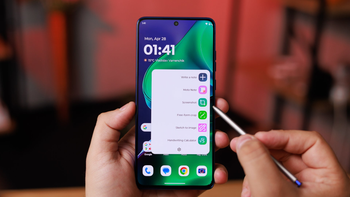


Things that are NOT allowed:
To help keep our community safe and free from spam, we apply temporary limits to newly created accounts: